Fairness¶
Scikit learn (pre version 1.2) came with the boston housing dataset. We can make a simple pipeline with it and make us a small model. We can even write the code to also make a plot that can convince us that we're doing well:
import matplotlib.pylab as plt
import seaborn as sns
sns.set_theme()
from sklearn.datasets import load_boston
from sklearn.pipeline import Pipeline
from sklearn.preprocessing import StandardScaler
from sklearn.linear_model import LinearRegression
X, y = load_boston(return_X_y=True)
pipe = Pipeline([
("scale", StandardScaler()),
("model", LinearRegression())
])
plt.scatter(pipe.fit(X, y).predict(X), y)
plt.xlabel("predictions")
plt.ylabel("actual")
plt.title("plot that suggests it's not bad");
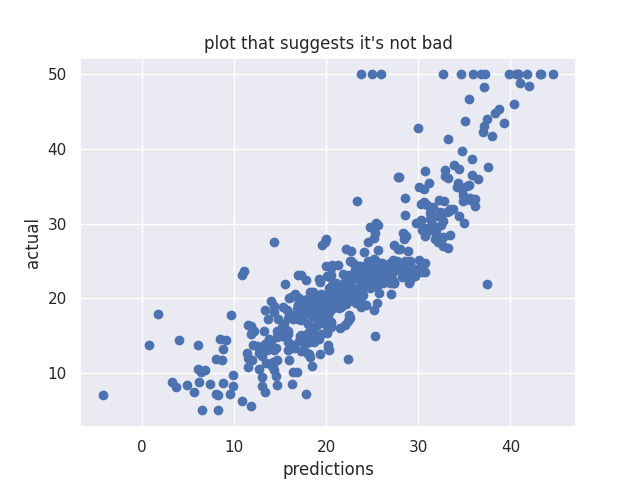
We could stop our research here if we think that our MSE is good enough but this would be dangerous. To find out why, we should look at the variables that are being used in our model.
Boston housing description
.. _boston_dataset:
Boston house prices dataset
---------------------------
**Data Set Characteristics:**
:Number of Instances: 506
:Number of Attributes: 13 numeric/categorical predictive. Median Value (attribute 14) is usually the target.
:Attribute Information (in order):
- CRIM per capita crime rate by town
- ZN proportion of residential land zoned for lots over 25,000 sq.ft.
- INDUS proportion of non-retail business acres per town
- CHAS Charles River dummy variable (= 1 if tract bounds river; 0 otherwise)
- NOX nitric oxides concentration (parts per 10 million)
- RM average number of rooms per dwelling
- AGE proportion of owner-occupied units built prior to 1940
- DIS weighted distances to five Boston employment centres
- RAD index of accessibility to radial highways
- TAX full-value property-tax rate per $10,000
- PTRATIO pupil-teacher ratio by town
- B 1000(Bk - 0.63)^2 where Bk is the proportion of black people by town
- LSTAT % lower status of the population
- MEDV Median value of owner-occupied homes in $1000's
This dataset contains features like "lower status of population" and "the proportion of blacks by town".
Danger
This is bad! There's a real possibility that our model will overfit on MSE and underfit on fairness when we want to apply it. Scikit-Lego has some support to deal with fairness issues like this one.
Dealing with issues such as fairness in machine learning can in general be done in three ways:
- Data preprocessing
- Model constraints
- Prediction postprocessing
Before we can dive into methods for getting more fair predictions, we first need to define how to measure fairness.
Measuring fairness for Regression¶
Measuring fairness can be done in many ways but we'll consider one definition: the output of the model is fair with regards to groups \(A\) and \(B\) if prediction has a distribution independent of group \(A\) or \(B\).
In laymans terms: if group \(A\) and \(B\) don't get the same predictions: no bueno.
Formally, how much the means of the distributions differ can be written as:
where \(Z_1\) is the subset of the population where our sensitive attribute is true, and \(Z_0\) the subset of the population where the sensitive attribute is false.
To estimate this we'll use bootstrap sampling to measure the models bias.
Measuring fairness for Classification¶
A common method for measuring fairness is demographic parity1, for example through the p-percent metric.
The idea is that a decision — such as accepting or denying a loan application — ought to be independent of the protected attribute. In other words, we expect the positive rate in both groups to be the same. In the case of a binary decision \(\hat{y}\) and a binary protected attribute \(z\), this constraint can be formalized by asking that
You can turn this into a metric by calculating how far short the decision process falls of this exact equality. This metric is called the p% score
In other words, membership in a protected class should have no correlation with the decision.
In sklego this metric is implemented in as p_percent_score and it works as follows:
import pandas as pd
from sklearn.linear_model import LogisticRegression
from sklego.metrics import p_percent_score
sensitive_classification_dataset = pd.DataFrame({
"x1": [1, 0, 1, 0, 1, 0, 1, 1],
"x2": [0, 0, 0, 0, 0, 1, 1, 1],
"y": [1, 1, 1, 0, 1, 0, 0, 0]}
)
X, y = sensitive_classification_dataset.drop(columns="y"), sensitive_classification_dataset["y"]
mod_unfair = LogisticRegression(solver="lbfgs").fit(X, y)
print("p_percent_score:", p_percent_score(sensitive_column="x2")(mod_unfair, X))
p_percent_score: 0
Of course, no metric is perfect. If, for example, we used this in a loan approval situation the demographic parity only looks at loans made and not at the rate at which loans are repaid.
That might result in a lower percentage of qualified people who are given loans in one population than in another. Another way of measuring fairness could therefore be to measure equal opportunity2, implemented in sklego as equal_opportunity_score. This constraint would boil down to:
and be turned into a metric in the same way as above:
We can see in the example below that the equal opportunity score does not differ for the models as long as the records where y_true = 1 are predicted correctly.
import numpy as np
import pandas as pd
from sklego.metrics import equal_opportunity_score
import types
sensitive_classification_dataset = pd.DataFrame({
"x1": [1, 0, 1, 0, 1, 0, 1, 1],
"x2": [0, 0, 0, 0, 0, 1, 1, 1],
"y": [1, 1, 1, 0, 1, 0, 0, 1]}
)
X, y = sensitive_classification_dataset.drop(columns="y"), sensitive_classification_dataset["y"]
mod_1 = types.SimpleNamespace()
mod_1.predict = lambda X: np.array([1, 0, 1, 0, 1, 0, 1, 1])
print("equal_opportunity_score:", equal_opportunity_score(sensitive_column="x2")(mod_1, X, y))
mod_1.predict = lambda X: np.array([1, 0, 1, 0, 1, 0, 0, 1])
print("equal_opportunity_score:", equal_opportunity_score(sensitive_column="x2")(mod_1, X, y))
mod_1.predict = lambda X: np.array([1, 0, 1, 0, 1, 0, 0, 0])
print("equal_opportunity_score:", equal_opportunity_score(sensitive_column="x2")(mod_1, X, y))
Data preprocessing¶
When doing data preprocessing we're trying to remove any bias caused by the sensitive variable from the input dataset. By doing this, we remain flexible in our choice of models.
Information Filter¶
This is a great opportunity to use the InformationFilter which can filter the information of these two sensitive columns away as a transformation step.
It does this by projecting all vectors away such that the remaining dataset is orthogonal to the sensitive columns.
How it works¶
The InformationFilter uses a variant of the Gram–Schmidt process to filter information out of the dataset. We can make it visual in two dimensions;
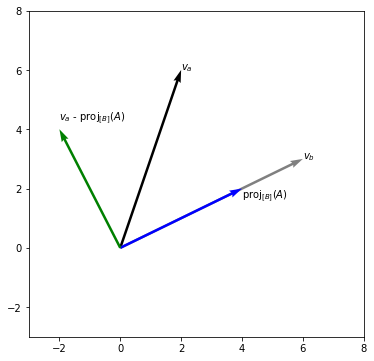
To explain what occurs in higher dimensions we need to resort to maths. Take a training matrix \(X\) that contains columns \(x_1, ..., x_k\).
If we assume columns \(x_1\) and \(x_2\) to be the sensitive columns then the information filter will filter out information using the following approach:
Concatenating our vectors (but removing the sensitive ones) gives us a new training matrix \(X_{\text{more fair}} = [v_3, ..., v_k]\).
Experiment¶
We will demonstrate the effect of applying this by benchmarking three things:
- Keep \(X\) as is.
- Drop the two columns that are sensitive.
- Use the information filter
We'll use the regression metric defined above to show the differences in fairness.
import pandas as pd
from sklearn.datasets import load_boston
from sklego.preprocessing import InformationFilter
X, y = load_boston(return_X_y=True)
df = pd.DataFrame(X,
columns=["crim", "zn", "indus", "chas", "nox", "rm", "age", "dis", "rad", "tax", "ptratio", "b", "lstat"]
)
X_drop = df.drop(columns=["lstat", "b"])
X_fair = InformationFilter(["lstat", "b"]).fit_transform(df)
X_fair = pd.DataFrame(X_fair, columns=[n for n in df.columns if n not in ["b", "lstat"]])
def simple_mod():
"""Create a simple model"""
return Pipeline([("scale", StandardScaler()), ("mod", LinearRegression())])
base_mod = simple_mod().fit(X, y)
drop_mod = simple_mod().fit(X_drop, y)
fair_mod = simple_mod().fit(X_fair, y)
base_pred = base_mod.predict(X)
drop_pred = drop_mod.predict(X_drop)
fair_pred = fair_mod.predict(X_fair)
We can see that the coefficients of the three models are indeed different.
coefs = pd.DataFrame([
base_mod.steps[1][1].coef_,
drop_mod.steps[1][1].coef_,
fair_mod.steps[1][1].coef_
],
columns=df.columns)
coefs
| crim | zn | indus | chas | nox | rm | age | dis | rad | tax | ptratio | b | lstat |
|---|---|---|---|---|---|---|---|---|---|---|---|---|
| -0.928146 | 1.08157 | 0.1409 | 0.68174 | -2.05672 | 2.67423 | 0.0194661 | -3.10404 | 2.66222 | -2.07678 | -2.06061 | 0.849268 | -3.74363 |
| -1.5814 | 0.911004 | -0.290074 | 0.884936 | -2.56787 | 4.2647 | -1.27073 | -3.33184 | 2.21574 | -2.05625 | -2.1546 | nan | nan |
| -0.763568 | 1.02805 | 0.0613932 | 0.697504 | -1.60546 | 6.84677 | -0.0579197 | -2.5376 | 1.93506 | -1.77983 | -2.79307 | nan | nan |
Utils
# We're using "lstat" to select the group to keep things simple
selector = df["lstat"] > np.quantile(df["lstat"], 0.5)
def bootstrap_means(preds, selector, n=2500, k=25):
grp1 = np.random.choice(preds[selector], (n, k)).mean(axis=1)
grp2 = np.random.choice(preds[~selector], (n, k)).mean(axis=1)
return grp1 - grp2
import matplotlib.pylab as plt
import seaborn as sns
from sklearn.metrics import mean_squared_error
sns.set_theme()
plt.figure(figsize=(10, 5))
plt.subplot(121)
plt.scatter(base_pred, y)
plt.title(f"MSE: {mean_squared_error(y, base_pred)}")
plt.subplot(122)
plt.hist(bootstrap_means(base_pred, selector), bins=30, density=True, alpha=0.8)
plt.title(f"Fairness Proxy");
plt.savefig(_static_path / "original-situation.png")
plt.clf()
import matplotlib.pylab as plt
import seaborn as sns
from sklearn.metrics import mean_squared_error
sns.set_theme()
plt.figure(figsize=(10, 5))
plt.subplot(121)
plt.scatter(drop_pred, y)
plt.title(f"MSE: {mean_squared_error(y, drop_pred)}")
plt.subplot(122)
plt.hist(bootstrap_means(base_pred, selector), bins=30, density=True, alpha=0.8)
plt.hist(bootstrap_means(drop_pred, selector), bins=30, density=True, alpha=0.8)
plt.title(f"Fairness Proxy");
plt.savefig(_static_path / "drop-two.png")
plt.clf()
import matplotlib.pylab as plt
import seaborn as sns
from sklearn.metrics import mean_squared_error
sns.set_theme()
plt.figure(figsize=(10, 5))
plt.subplot(121)
plt.scatter(fair_pred, y)
plt.title(f"MSE: {mean_squared_error(y, fair_pred)}")
plt.subplot(122)
plt.hist(bootstrap_means(base_pred, selector), bins=30, density=True, alpha=0.8)
plt.hist(bootstrap_means(fair_pred, selector), bins=30, density=True, alpha=0.8)
plt.title(f"Fairness Proxy");
plt.savefig(_static_path / "use-info-filter.png")
plt.clf()
from sklego.linear_model import DemographicParityClassifier
from sklearn.linear_model import LogisticRegression
from sklego.metrics import p_percent_score
df_clf = df.assign(lstat=lambda d: d["lstat"] > np.median(d["lstat"]))
y_clf = y > np.median(y)
normal_classifier = LogisticRegression(solver="lbfgs")
_ = normal_classifier.fit(df_clf, y_clf)
fair_classifier = DemographicParityClassifier(sensitive_cols="lstat", covariance_threshold=0.5)
_ = fair_classifier.fit(df_clf, y_clf)
from sklearn.metrics import accuracy_score, make_scorer
from sklearn.model_selection import GridSearchCV
fair_classifier = GridSearchCV(
estimator=DemographicParityClassifier(sensitive_cols="lstat", covariance_threshold=0.5),
param_grid={"estimator__covariance_threshold": np.linspace(0.01, 1.00, 20)},
cv=5,
refit="accuracy_score",
return_train_score=True,
scoring={
"p_percent_score": p_percent_score("lstat"),
"accuracy_score": make_scorer(accuracy_score)
}
)
fair_classifier.fit(df_clf, y_clf)
pltr = (pd.DataFrame(fair_classifier.cv_results_)
.set_index("param_estimator__covariance_threshold"))
p_score = p_percent_score("lstat")(normal_classifier, df_clf, y_clf)
acc_score = accuracy_score(normal_classifier.predict(df_clf), y_clf)
import matplotlib.pylab as plt
import seaborn as sns
sns.set_theme()
plt.figure(figsize=(12, 3))
plt.subplot(121)
plt.plot(np.array(pltr.index), pltr["mean_test_p_percent_score"], label="fairclassifier")
plt.plot(np.linspace(0, 1, 2), [p_score for _ in range(2)], label="logistic-regression")
plt.xlabel("covariance threshold")
plt.legend()
plt.title("p% score")
plt.subplot(122)
plt.plot(np.array(pltr.index), pltr["mean_test_accuracy_score"], label="fairclassifier")
plt.plot(np.linspace(0, 1, 2), [acc_score for _ in range(2)], label="logistic-regression")
plt.xlabel("covariance threshold")
plt.legend()
plt.title("accuracy");
plt.savefig(_static_path / "demographic-parity-grid-results.png")
plt.clf()
from sklego.linear_model import EqualOpportunityClassifier
fair_classifier = GridSearchCV(
estimator=EqualOpportunityClassifier(
sensitive_cols="lstat",
covariance_threshold=0.5,
positive_target=True,
),
param_grid={"estimator__covariance_threshold": np.linspace(0.001, 1.00, 20)},
cv=5,
n_jobs=-1,
refit="accuracy_score",
return_train_score=True,
scoring={
"p_percent_score": p_percent_score("lstat"),
"equal_opportunity_score": equal_opportunity_score("lstat"),
"accuracy_score": make_scorer(accuracy_score)
}
)
fair_classifier.fit(df_clf, y_clf)
pltr = (pd.DataFrame(fair_classifier.cv_results_)
.set_index("param_estimator__covariance_threshold"))
p_score = p_percent_score("lstat")(normal_classifier, df_clf, y_clf)
acc_score = accuracy_score(normal_classifier.predict(df_clf), y_clf)
import matplotlib.pylab as plt
import seaborn as sns
sns.set_theme()
plt.figure(figsize=(12, 3))
plt.subplot(121)
plt.plot(np.array(pltr.index), pltr["mean_test_equal_opportunity_score"], label="fairclassifier")
plt.plot(np.linspace(0, 1, 2), [p_score for _ in range(2)], label="logistic-regression")
plt.xlabel("covariance threshold")
plt.legend()
plt.title("equal opportunity score")
plt.subplot(122)
plt.plot(np.array(pltr.index), pltr["mean_test_accuracy_score"], label="fairclassifier")
plt.plot(np.linspace(0, 1, 2), [acc_score for _ in range(2)], label="logistic-regression")
plt.xlabel("covariance threshold")
plt.legend()
plt.title("accuracy");
plt.savefig(_static_path / "equal-opportunity-grid-results.png")
plt.clf()
1. Original Situation¶
Code to generate the plot
import matplotlib.pylab as plt
import seaborn as sns
from sklearn.metrics import mean_squared_error
sns.set_theme()
plt.figure(figsize=(10, 5))
plt.subplot(121)
plt.scatter(base_pred, y)
plt.title(f"MSE: {mean_squared_error(y, base_pred)}")
plt.subplot(122)
plt.hist(bootstrap_means(base_pred, selector), bins=30, density=True, alpha=0.8)
plt.title(f"Fairness Proxy");
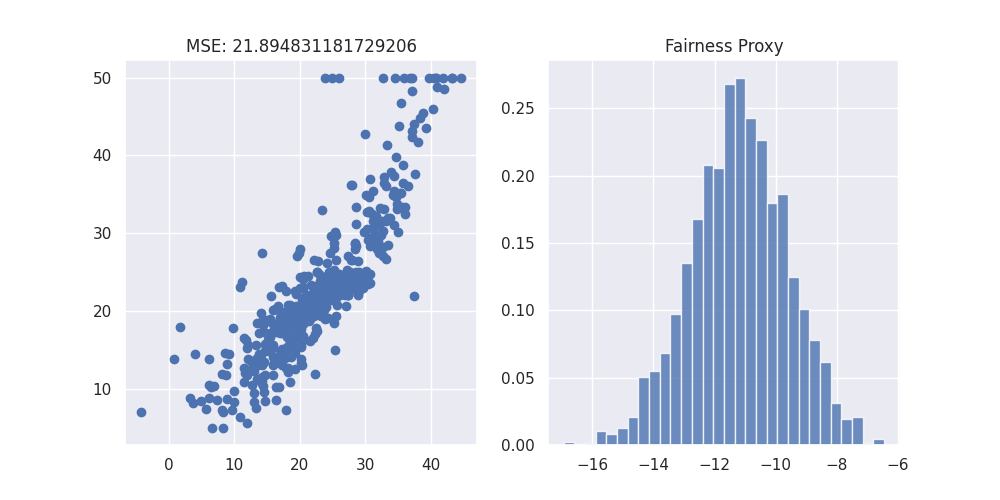
2. Drop two columns¶
Code to generate the plot
import matplotlib.pylab as plt
import seaborn as sns
from sklearn.metrics import mean_squared_error
sns.set_theme()
plt.figure(figsize=(10, 5))
plt.subplot(121)
plt.scatter(drop_pred, y)
plt.title(f"MSE: {mean_squared_error(y, drop_pred)}")
plt.subplot(122)
plt.hist(bootstrap_means(base_pred, selector), bins=30, density=True, alpha=0.8)
plt.hist(bootstrap_means(drop_pred, selector), bins=30, density=True, alpha=0.8)
plt.title(f"Fairness Proxy");
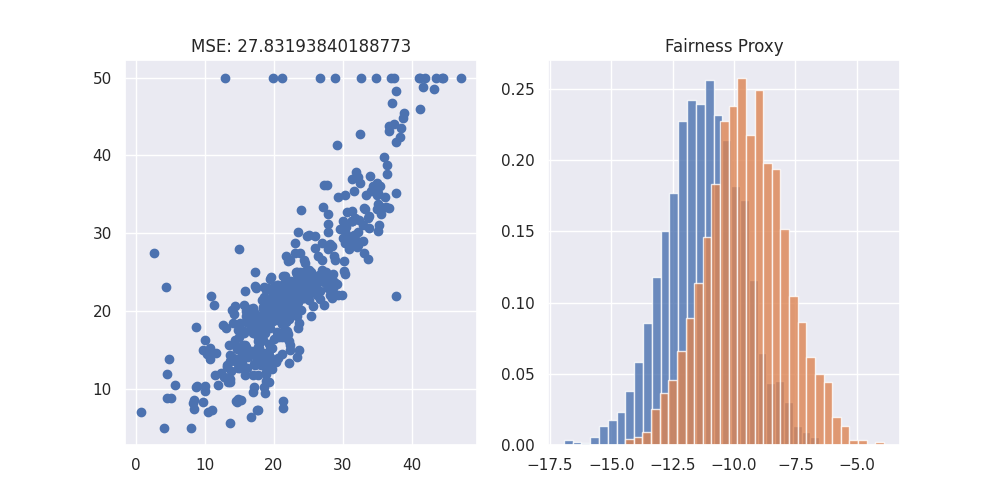
3. Use the Information Filter¶
Code to generate the plot
import matplotlib.pylab as plt
import seaborn as sns
from sklearn.metrics import mean_squared_error
sns.set_theme()
plt.figure(figsize=(10, 5))
plt.subplot(121)
plt.scatter(fair_pred, y)
plt.title(f"MSE: {mean_squared_error(y, fair_pred)}")
plt.subplot(122)
plt.hist(bootstrap_means(base_pred, selector), bins=30, density=True, alpha=0.8)
plt.hist(bootstrap_means(fair_pred, selector), bins=30, density=True, alpha=0.8)
plt.title(f"Fairness Proxy");
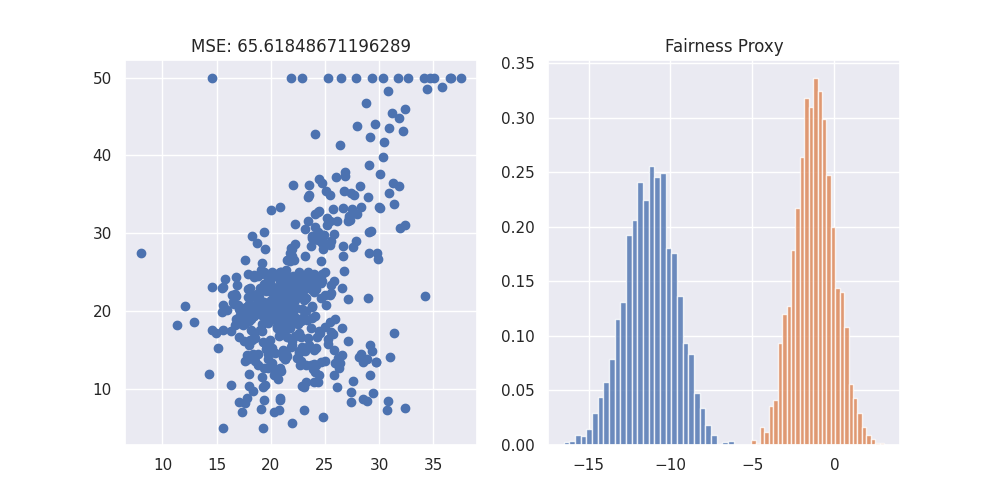
There definitely is a balance between fairness and model accuracy. Which model you'll use depends on the world you want to create by applying your model.
Note that you can combine models here to make an ensemble too. You can also use the difference between the first and last model as a proxy for bias.
Model constraints¶
Another way we could tackle this fairness problem would be to explicitly take fairness into account when optimizing the parameters of our model. This is implemented in the DemographicParityClassifier as well as the EqualOpportunityClassifier.
Both these models are built as an extension of basic logistic regression. Where logistic regression optimizes the following problem:
We would like to instead optimize this:
Demographic Parity Classifier¶
The p% score discussed above is a nice metric but unfortunately it is rather hard to directly implement in the formulation into our model as it is a non-convex function making it difficult to optimize directly. Also, as the p% rule only depends on which side of the decision boundary an observation lies, it is invariant in small changes in the decision boundary. This causes large saddle points in the objective making optimization even more difficult
Instead of optimizing for the p% directly, we approximate it by taking the covariance between the users’ sensitive
attributes, \(z\)m, and the decision boundary. This results in the following formulation of our DemographicParityClassifier.
Let's see what the effect of this is. As this is a Classifier and not a Regressor, we transform the target to a binary variable indicating whether it is above or below the median. Our p% metric also assumes a binary indicator for sensitive columns so we do the same for our lstat column.
Fitting the model is as easy as fitting a normal sklearn model. We just need to supply the columns that should be treated as sensitive to the model, as well as the maximum covariance we want to have.
from sklego.linear_model import DemographicParityClassifier
from sklearn.linear_model import LogisticRegression
from sklego.metrics import p_percent_score
df_clf = df.assign(lstat=lambda d: d["lstat"] > np.median(d["lstat"]))
y_clf = y > np.median(y)
normal_classifier = LogisticRegression(solver="lbfgs")
_ = normal_classifier.fit(df_clf, y_clf)
fair_classifier = DemographicParityClassifier(sensitive_cols="lstat", covariance_threshold=0.5)
_ = fair_classifier.fit(df_clf, y_clf)
Comparing the two models on their p% scores also shows that the fair classifier has a much higher fairness score at a slight cost in accuracy.
We'll compare these two models by doing a gridsearch on the effect of the covariance_threshold.
from sklearn.metrics import accuracy_score, make_scorer
from sklearn.model_selection import GridSearchCV
fair_classifier = GridSearchCV(
estimator=DemographicParityClassifier(sensitive_cols="lstat", covariance_threshold=0.5),
param_grid={"estimator__covariance_threshold": np.linspace(0.01, 1.00, 20)},
cv=5,
refit="accuracy_score",
return_train_score=True,
scoring={
"p_percent_score": p_percent_score("lstat"),
"accuracy_score": make_scorer(accuracy_score)
}
)
fair_classifier.fit(df_clf, y_clf)
pltr = (pd.DataFrame(fair_classifier.cv_results_)
.set_index("param_estimator__covariance_threshold"))
p_score = p_percent_score("lstat")(normal_classifier, df_clf, y_clf)
acc_score = accuracy_score(normal_classifier.predict(df_clf), y_clf)
The results of the grid search are shown below. Note that the logistic regression results are of the train set, not the test set. We can see that the increase in fairness comes at the cost of accuracy but this might literally be a fair tradeoff.
Code to generate the plot
import matplotlib.pylab as plt
import seaborn as sns
sns.set_theme()
plt.figure(figsize=(12, 3))
plt.subplot(121)
plt.plot(np.array(pltr.index), pltr["mean_test_p_percent_score"], label="fairclassifier")
plt.plot(np.linspace(0, 1, 2), [p_score for _ in range(2)], label="logistic-regression")
plt.xlabel("covariance threshold")
plt.legend()
plt.title("p% score")
plt.subplot(122)
plt.plot(np.array(pltr.index), pltr["mean_test_accuracy_score"], label="fairclassifier")
plt.plot(np.linspace(0, 1, 2), [acc_score for _ in range(2)], label="logistic-regression")
plt.xlabel("covariance threshold")
plt.legend()
plt.title("accuracy");

Equal opportunity¶
In the same spirit as the DemographicParityClassifier discussed above, there is also an EqualOpportunityClassifier which optimizes
where POS is the subset of the population where y_true = positive_target.
from sklego.linear_model import EqualOpportunityClassifier
fair_classifier = GridSearchCV(
estimator=EqualOpportunityClassifier(
sensitive_cols="lstat",
covariance_threshold=0.5,
positive_target=True,
),
param_grid={"estimator__covariance_threshold": np.linspace(0.001, 1.00, 20)},
cv=5,
n_jobs=-1,
refit="accuracy_score",
return_train_score=True,
scoring={
"p_percent_score": p_percent_score("lstat"),
"equal_opportunity_score": equal_opportunity_score("lstat"),
"accuracy_score": make_scorer(accuracy_score)
}
)
fair_classifier.fit(df_clf, y_clf)
pltr = (pd.DataFrame(fair_classifier.cv_results_)
.set_index("param_estimator__covariance_threshold"))
p_score = p_percent_score("lstat")(normal_classifier, df_clf, y_clf)
acc_score = accuracy_score(normal_classifier.predict(df_clf), y_clf)
Code to generate the plot
import matplotlib.pylab as plt
import seaborn as sns
sns.set_theme()
plt.figure(figsize=(12, 3))
plt.subplot(121)
plt.plot(np.array(pltr.index), pltr["mean_test_equal_opportunity_score"], label="fairclassifier")
plt.plot(np.linspace(0, 1, 2), [p_score for _ in range(2)], label="logistic-regression")
plt.xlabel("covariance threshold")
plt.legend()
plt.title("equal opportunity score")
plt.subplot(122)
plt.plot(np.array(pltr.index), pltr["mean_test_accuracy_score"], label="fairclassifier")
plt.plot(np.linspace(0, 1, 2), [acc_score for _ in range(2)], label="logistic-regression")
plt.xlabel("covariance threshold")
plt.legend()
plt.title("accuracy");
